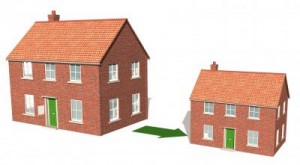
In times of recession, moving to a smaller home or office is commonplace. We call it downsizing – a simple way to not only reduce your overheads but to have a jolly good clear out and create some space for your next move. Your new property will be more manageable and will, of course, make financial sense.
But what about your belongings? What will you do with all of those antiques, possessions, books and files that you have built up over the years? What about the kids’ stuff which you want to get rid of, but can’t? What about the furniture that was suitable in the garden of your three bedroom semi-detached, but will not squeeze into the back garden of your new home?
The options are these. When downsizing, you can De-clutter, make numerous trips to the local refuse tip and then regret your decision or you can look into the possibility of Self storage, thus keeping your possessions together in a safe, damp free environment. After all, why get rid of them? You never know when your circumstances might be reversed. None of us know exactly what lies around the corner.
If you choose to go down the route of self storage, contact your local self storage centre and book an appointment at the site to see what size and type of unit would best suit you. Ask about deals that might be available, the cost of insurance and of course, whether or not you are locked into a long-term agreement.
Secondly, make a list of goods you honestly don’t want, ones that you will need to replace when you move and others that are of no use in the short-term, but will be in the future. When you’ve done that and stripped your rooms, it’s time to pack the goods you need and transfer them to your chosen self storage site. The rest will be coming with you.
Tips on packing
- Each time you pack a box, label it clearly with a marker pen and indicate the contents on a side that’s easily visible when the box is stacked.
- Don’t forget that books and papers can be heavy: packing these in smaller containers will help prevent injury while lifting.
- Sturdy packaging means you can stack your goods and minimise the amount of space you need.
- Boxes should be filled to capacity to prevent tipping, but weight may mean it’s better to have more smaller boxes than larger ones.
- Make sure you leave a pathway to the back of your unit to ensure ease of access
Lucinda Dangerfield is co-owner of Space Centre Self Storage, who have sites in the North Bristol and Gloucestershire area of south west England said; “We see a lot of people downsizing and most will have bags and boxes of valuables that they want to keep but have no room for in their new property.
”Families are reluctant to rid themselves of the contents of their child’s bedroom once they have flown the nest. Equally, if a family does downsize to a flat or a much smaller property, they will invariably have garden furniture and tools that they may not need in the immediate future but they won’t sell just in case,
“Some will store them with us and then, later along the line, make a decision on whether or not to sell. It’s the same with a lot of their household goods too.
“Once they have stored them, they can revisit that possibility at a date in the future and make a bit of money from goods and belongings that they will never use.”
If you have any questions about downsizing or how you can choose the right size unit or even which goods can and cannot be stored with us, why not contact us through the website?
Have you downsized and used self storage to hang on to belongings you can’t bear to part with? Share your tips with our readers in the comment box below.